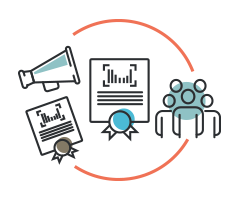WP 1 – Project management and innovation
Ensure a proper implementation of the project:
- Establish technical systems and principles for sharing information, project management and decision making
- Manage progress, risks, publication and report to the European Commission
- Ensure a proper multi-actor approach and to facilitate the innovation processes
WP 2 – Shelf life prediction and labelling
Develop, prototype and demonstrate tools and solutions for microbiome-based technology to better predict and inform about remaining shelf life of fresh chicken and salmon:
- Develop a model for prediction of the shelf life of food products both at the time they leave the factory and at any point in the downstream value chain
- Develop and test spoilage sensors and labelling solutions for predicting and displaying dynamic shelf life
- Develop rapid diagnostic detection assays for improved microbiome factory process control
- Document the methodology used to determine shelf life using microbiome and factory production process data
- Demonstrate an integrated use of the technologies in the chicken chain
WP 3 – Microbial preservatives
Develop, prototype and demonstrate solutions for microbiome-based protection technology to improve the shelf life, quality and safety of fresh chicken, cold smoked salmon (CSS), and plant-based meat analogues:
- Develop recommendation guidelines for selection and evaluation of bacterial strains as protective food cultures
- Generate new knowledge on the microbial spoilage of plant-based meat analogues
- Develop and industrially validate at least three new applicable microbial-based preservation solutions
- Develop an industrially validated prototype of a new plant-based meat analogue product with food cultures
- Address safety of microbiome-based solutions by evaluating their effect on the human gut microbiome
WP 4 – Packaging solutions
Develop and validate packaging solutions that extends shelf life, keeps food safe, and supports sustainable development. Specific objectives will be:
- Development of new packaging systems with improved recyclability for fresh chicken, cold smoked salmon, and meat analogues, optimized for lowest possible overall environmental footprint
- Investigate the role of anoxia (vacuum or skin packaging) and modified atmosphere packaging (MAP) on the food/ spoilage microbiome, both in products treated with microbiome-based preservation technology and without
- Exploit the integration of smart label spoilage sensors in new packaging systems
- Demonstrate active packaging through surface coating of food packaging film with microbial metabolite mixture
WP 5 – Consumer acceptance and social economic, and environmental sustainability
Evaluate MICROORC solutions and prototypes for shelf-life extension (i.e.: shelf-life prediction & labelling (WP2), microbiome-based protection technology (WP3), and packaging systems (WP4)) with respect to consumer acceptance, market potential, economy, environmental footprint, and potential to reduce food waste. Specifically:
- Identify best practice methods for shelf-life determination based on sensory analysis and consumer acceptance
- Identify consumers attitudes, perception and social readiness level for MICROORC tools and technologies
- Use LCA methodology to investigate the potential of tools & technologies to support innovation & development
- Perform a whole system level comparative multi-criteria sustainability assessment (MCSA) for selected food supply value chains
WP 6 – Regulation and policy recommendations
Understand the legal space relevant for MICROORC solutions and prototypes for shelf-life extension and evaluate these in a regulatory perspective:
- Identify for the project relevant supporting and undermining policies and regulations (enablers and restraints)
- Identify different interpretations of policies and regulations (grey areas)
- Deliver recommendations on how future policies and regulations might look like and the way forward to change
WP 7 – Stakeholders outreach, communication, dissemination and exploitation
Design and execute Communication, Dissemination and Exploitation (CD&E) to maximise the expected impacts
- Outline an integrated Plan for CD&E of results, describing the methodological framework and workflow
- Conduct a stakeholder mapping to analyse key stakeholders for MICROORC
- Develop a wide range of C&D tools to facilitate knowledge transfer and public outreach
- Facilitate dialogue with policymakers and other key stakeholders in the food value chain
- Consolidate the post-project exploitation strategy for the project
The MICROORC project is organized into seven work packages, designed to address the project specific objectives.







 Funded by the
European Union under Grant Agreement N° 101136248. Views and opinions expressed are however those of the
author(s) only and do not necessarily reflect those of the European Union or REA. Neither the European
Union nor REA can be held responsible for them.
Funded by the
European Union under Grant Agreement N° 101136248. Views and opinions expressed are however those of the
author(s) only and do not necessarily reflect those of the European Union or REA. Neither the European
Union nor REA can be held responsible for them.